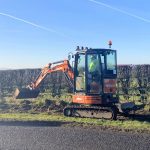Challenges Remain as Openreach Improve UK Cable Duct and Pole Access UPDATE
Last week saw Openreach (BT) publish a Final Reference Offer for their revised Physical Infrastructure Access (PIA) product, which is intended to make it cheaper and easier for UK ISPs to deploy their own “full fibre” broadband networks via existing cable ducts and poles. But some challenges remain.
Openreach have been offering a PIA solution for ISPs to access and use their physical infrastructure for several years already, although few seemed to be happy with the old model. Many of those that did take it for a spin would complain it was cumbersome (administration) to use and suffered from awkward costs.
The old approach was also more intended for helping to connect residential homes, which meant that using it to provide leased line style rural backhaul or big business connectivity wasn’t possible, even though this helps alternative network (AltNet) ISPs to build a more economically viable model.
Advertisement
Ofcom’s 2016 Strategic Review deal with BT set out to resolve all this via an enhanced Duct and Pole Access (DPA) approach. At the start of 2018 they followed that by telling Openreach (here) to make sure their ducts were “ready for use” (i.e. repairing faults or relieving congested sections), delivered better rentals, improved information sharing (e.g. digital maps), offered more efficient operational processes and supported mixed usage (i.e. ISPs can deploy local access networks offering both broadband and non-broadband services, provided the primary purpose of the network is the delivery of broadband).
Openreach followed this up in August 2018 with the publication of their first Draft Reference Offer for a revised PIA product, although at the time it was still lacking several of the required changes (here). However the operator has now published their Final Reference Offer (PDF) ahead of the product launch. As a result we’ve spoken to several alternative network (altnet) ISPs to get their views on this version.
Overall the ISPs welcome Openreach’s improvements but they also point to a number of problem areas and some question whether it will deliver the necessary improvement to “full fibre” roll-outs across the UK. Sadly only Cityfibre was able to offer a public comment but we’ve summarised some of the general feedback below.
Greg Mesch, CEO of Cityfibre, told ISPreview.co.uk:
“Duct and Pole Access (DPA) was an intervention created to increase the speed and decrease the cost at which competitors to BT Openreach could deploy their networks. While BT Openreach’s DPA product holds some promise, it will not currently increase the speed at which CityFibre can deploy, or reduce our costs of doing so.
We are working closely with BT Openreach and Ofcom to refine this product but there remains a long way to go before it is fit for purpose. It has not been designed for competitors like us that are planning and rolling out city-wide deployments at scale. As a tool it is fragmented, restrictive and inefficient – currently it is unusable throughout the whole of Scotland.
While we remain heavily involved in helping to improve and shape DPA, it is also critical to recognise that fundamentally DPA remains a product operated by a competitor. Until BT Openreach is obliged to reserve access for its own fibre roll-outs through the same product and is made to jump through the same hoops as challengers, DPA will remain a fundamentally non-equivalent proposition and its full potential to accelerate competitive rollouts unrealised.”
Experiences differ between the ISPs as not all follow the same approach, yet there were some areas of shared concern. For example, most agreed that the Network Adjustment process (i.e. where Openreach are required to make their network useable in specific permitted circumstances) was still too “clunky” or “inefficient“.
Advertisement
Similarly, on the issue of Scotland highlighted above by Cityfibre, this reflects the complex clash of wayleave (land access) agreements. Essentially many of Openreach’s PIA assets (poles etc.) are located on private land and as such the ISPs would require a wayleave to access the infrastructure itself. Realistically this may not be within Openreach’s power to resolve.
Since the draft version, Openreach has also introduced some limited Service Level Agreements (SLAs) and Guarantees (SLGs) to PIA, although among the larger ISPs there’s a feeling that these still need to be improved so as to make the product more predictable and give them confidence to adopt it at scale.
An Openreach Spokesperson told ISPreview.co.uk:
“Like the government and Ofcom, we recognise the importance of full fibre infrastructure competition. So whilst we’re scaling up and building, we’ll also be helping others to build by having access to our ducts and poles.
Since publishing our draft reference offer for Passive Infrastructure Access (PIA) in August 2018, we’ve worked closely with our customers and wider industry through the Passive Industry Working Group to develop a PIA product which is highly useable and scalable. This will allow our customers to deploy their own networks, supporting the delivery of faster, more reliable broadband to their customers and ultimately supporting the government’s ambition to deploy Full Fibre to 15 million homes by 2025.
We want to be a dependable partner for all our customers who want to use our ducts and poles, and we’ll continue to work closely with industry over the coming months as the product continues to evolve.”
The new product is due to be introduced on 1st April 2019 but it’s not the end of the road for PIA changes. Most of the respondents to our queries appear to view Openreach’s reference offer as a sort of “baseline” on which to make further improvements and there will be a 1 year bedding-in period before SLGs are applied, as well as future reviews in order to assess its progress.
Two of the ISPs we engaged with also appear to be expecting further refinements to the arrangements for forecasting, network adjustments and KPIs during the first year of implementation. Likewise Ofcom’s forthcoming Physical Infrastructure Market Review (PIMR), due this summer (here), looks set to require the adoption of “unrestricted usage” (instead of mixed usage) and possibly better SLAs.
Advertisement
Similarly some of the remaining issues, such as the aforementioned one with wayleaves on private land, are probably more a matter for the Government to resolve. The prize for getting this right could, according to Ofcom, “fundamentally change the business case for building new networks … It could cut the upfront costs of laying fibre cables by around 50% – from £500 per home, to £250. It could also reduce the time required for digging works, enabling fibre to be installed in some streets in a matter of hours.”
UPDATE 30th March 2019
Hyperoptic has finally given us a comment.
Dana Tobak, CEO of Hyperoptic, said:
“Granting competitors the right to deploy their fibre in Openreach’s ducts and poles unleashed a tidal wave of optimism that a shift in the balance of power in the broadband market was in reach. As things stand, the wave is heading for a crash, putting at risk Government’s hopes of vibrant competition in fibre rollout.
Openreach has no incentive to treat its competitors fairly – instead it is attempting to slow us down and make us pay to unblock and repair its Victorian infrastructure.”
Mark is a professional technology writer, IT consultant and computer engineer from Dorset (England), he also founded ISPreview in 1999 and enjoys analysing the latest telecoms and broadband developments. Find me on X (Twitter), Mastodon, Facebook, BlueSky, Threads.net and Linkedin.
« Ofcom UK Tell Lycamobile to Refund Surcharges for EU Roaming


















































Comments are closed